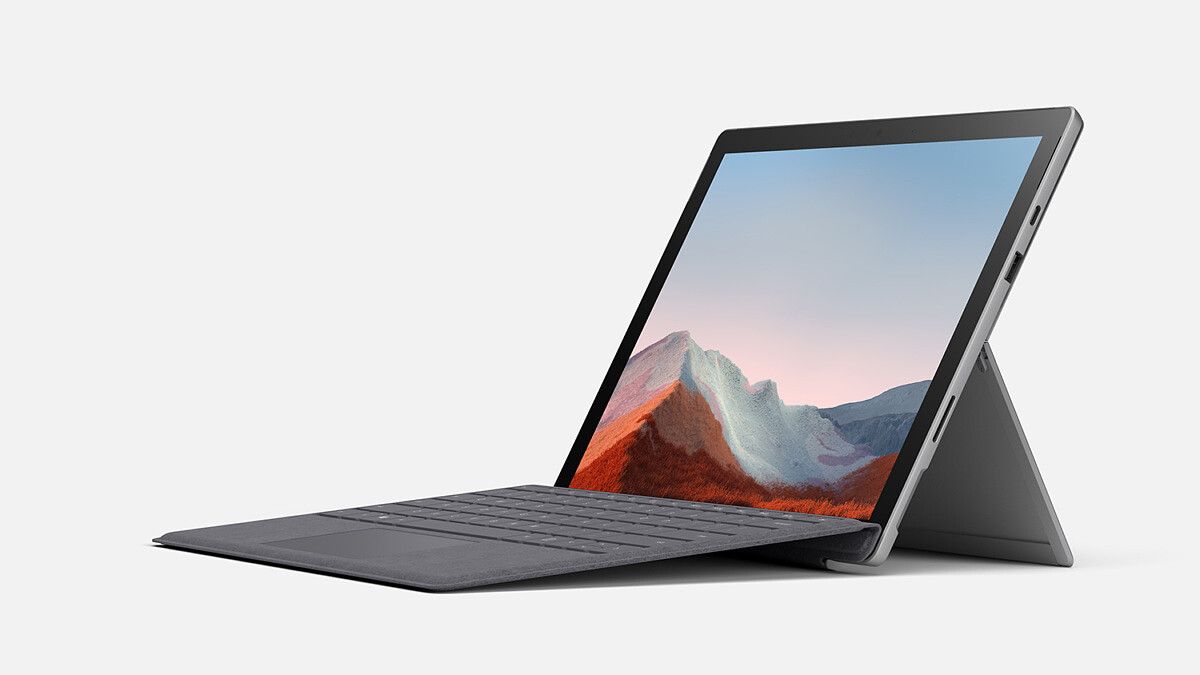CES is underway this week, and we've already seen new PCs from brands like HP and Lenovo. Microsoft today unveiled a new model in its Surface lineup, but they're targeting this PC for businesses and educational institutions that want to get their users ready for remote work and learning. The new Microsoft Surface Pro 7 Plus is thus part of Microsoft's Surface for Business portfolio as it's designed to offer users flexibility in how they want to work.
Like other Surface Pro models, the Surface Pro 7 Plus is a thin tablet that can dock into Microsoft's Type Cover to turn it into a laptop. It has a kickstand on the back to prop the tablet up at multiple angles, and it comes with an optional pen for drawing or taking notes. The Surface Pro 7 Plus supports connecting to 4G LTE networks via the built-in Snapdragon X20 modem once the eSIM or physical SIM has been provisioned, making the 2-in-1 device the perfect on-the-go workstation.
The Surface Pro 7 Plus is powered by Intel's 11th Gen "Tiger Lake" processor, starting from Intel's Core i3 (1115G4) all the way up to Intel's Core i7 (1165G7). The base i3 model with 8GB of RAM and 128GB of storage starts at $899, while the highest-end i7 model tops out at 32GB of RAM and 1TB of SSD storage for $2,799. According to The Verge, only the Intel Core i5 (1135G7) model at $1,149 will have optional LTE support, which certainly simplifies things for businesses and educational institutions but means there are fewer options if you want on-the-go connectivity and the best performance.
Microsoft claims the Surface Pro 7 Plus can last up to 15 hours on a single charge with its 50.4 watt-hour battery. That's an increase of 4.5 hours over the original Surface Pro 7, which isn't too surprising as that model has a 46.5 watt-hour battery. Otherwise, the Surface Pro 7 Plus ships with the same 12.3" 2736x1824 resolution display, a single Type-C port, a single Type-A port, a 3.5mm audio jack, Microsoft's Surface Connect port, and a microSDXC card reader in the WiFi-only models (the LTE model swaps this for a nanoSIM card slot).
For security, Microsoft made a couple of other notable changes from the original Surface Pro 7. The new Plus model has a removable SSD for data retention (as previously seen in the Pro X and Laptop 3) and features Windows Enhanced Hardware Security features enabled by default, according to Microsoft. The latter means that the Surface Pro 7 Plus has protections against privilege escalation attacks that target the device's memory. Called virtualization-based security (VBS) and Hypervisor-protected code integrity (HVCI), these two hardware security features are enabled by default on all Surface Pro 7 Plus devices to isolate memory from the main OS. Both VBS and HVCI are already enabled on Microsoft's other recent Surface devices, including the Surface Book 3, the Surface Laptop Go, and the Surface Pro X. As noted by BleepingComputer, the Surface Pro 7 Plus also features Secure Boot to check the boot firmware for any signs of tampering, a TPM chip for data encryption, and Windows Hello support for passwordless sign-in.
According to The Verge, Microsoft sees the new Surface Pro 7 Plus as simply an extension of its existing commercially-focused line rather than an entirely new line as was previously rumored. That's why there aren't any major external design changes, even though the inside changed substantially to accommodate the removable SSD and create more space for the larger battery. Any significant external design changes — such as to the bezel size — would "require significant change in terms of form factor and compatibility with previous [models]", according to Microsoft's Robin Seiler in an interview with The Verge. Thus, if you were hoping to pick one of these up for yourself, you're better off waiting for the true next-gen model, as the Surface Pro 7 Plus is clearly designed with businesses in mind despite its significant processing and connectivity upgrades.
The new Surface Pro 7 Plus will ship to customers via authorized resellers later this week in the US and is expected to become available in Canada, Australia, New Zealand, the UK, and other European countries soon.

